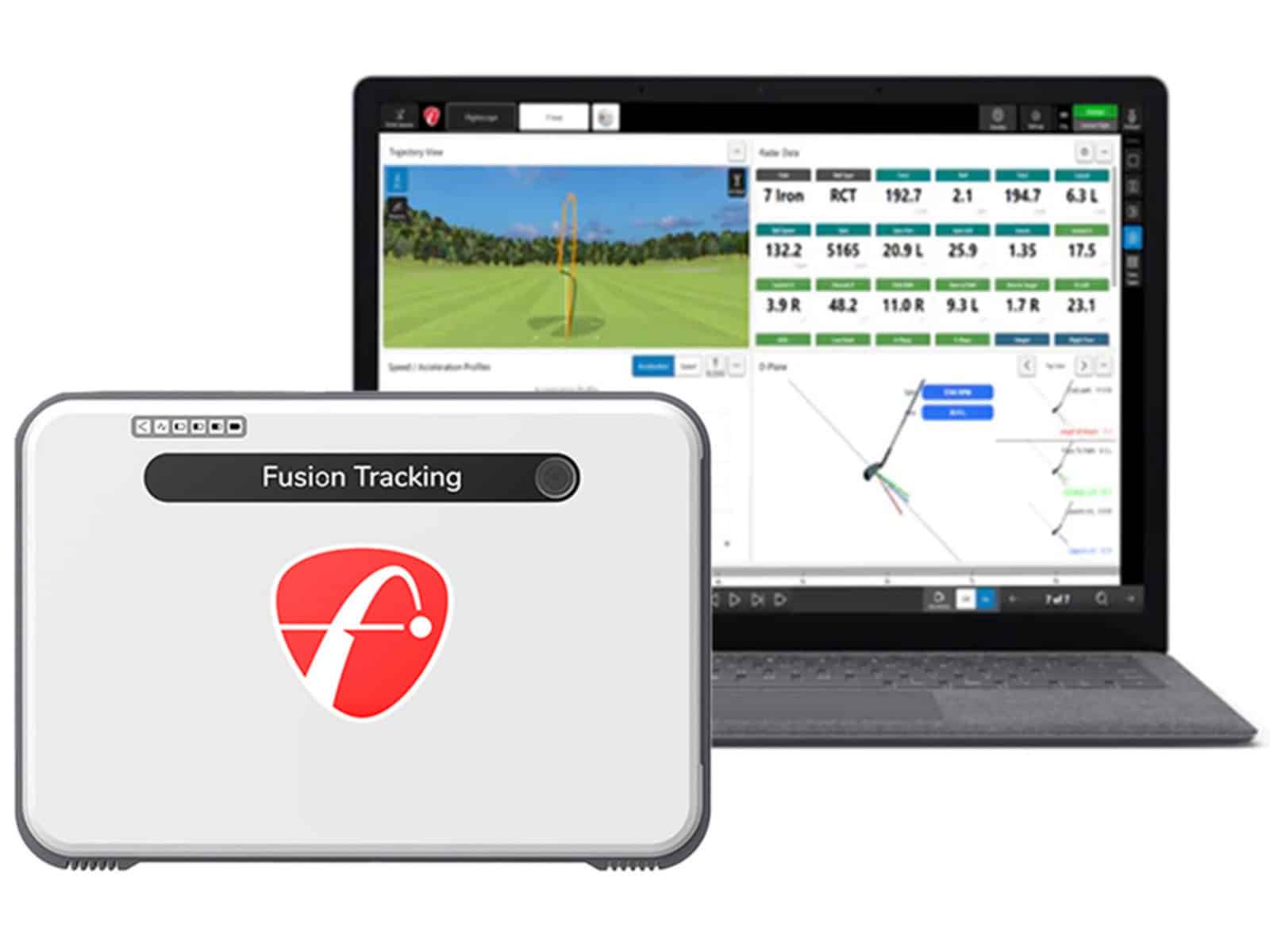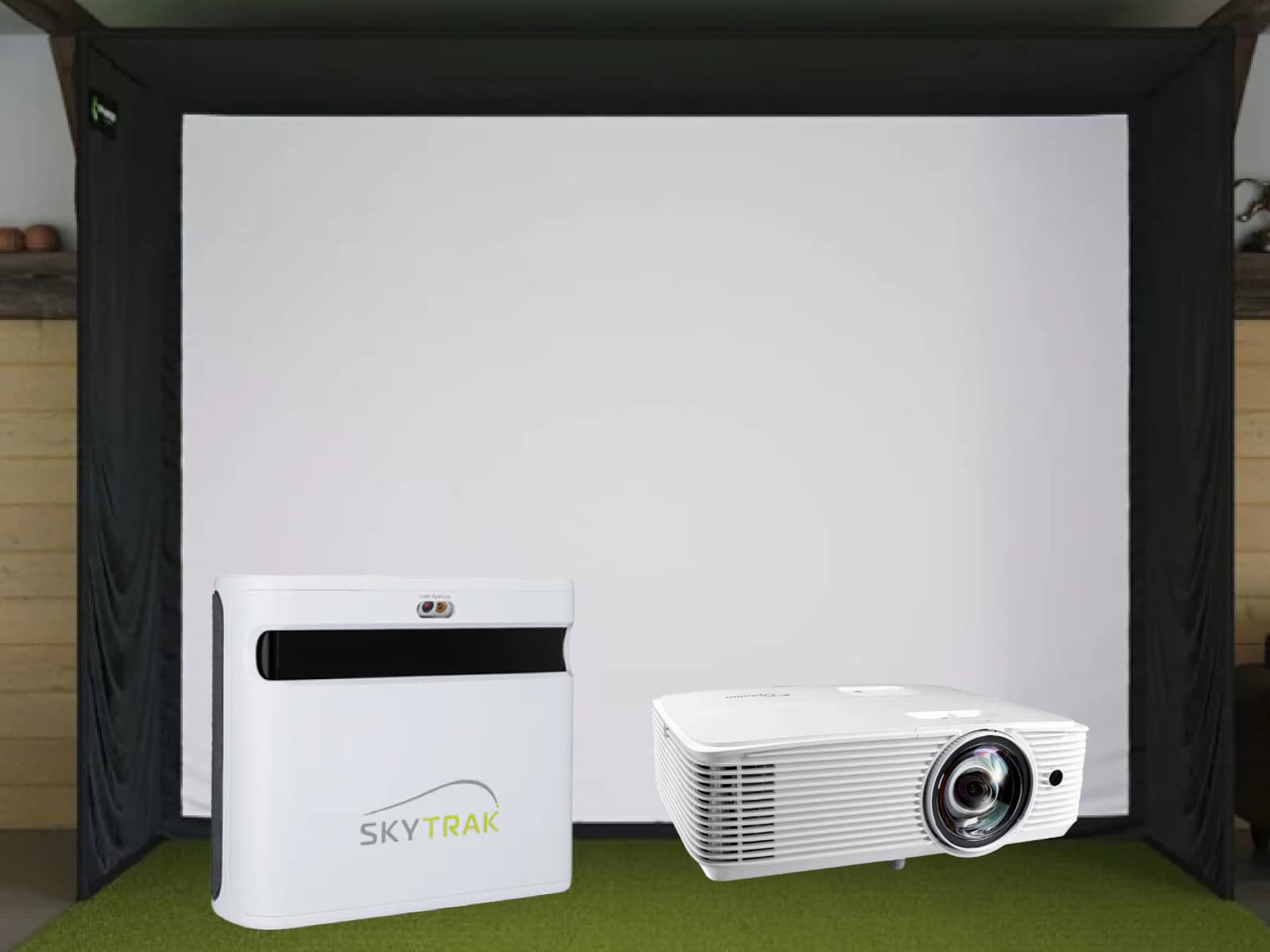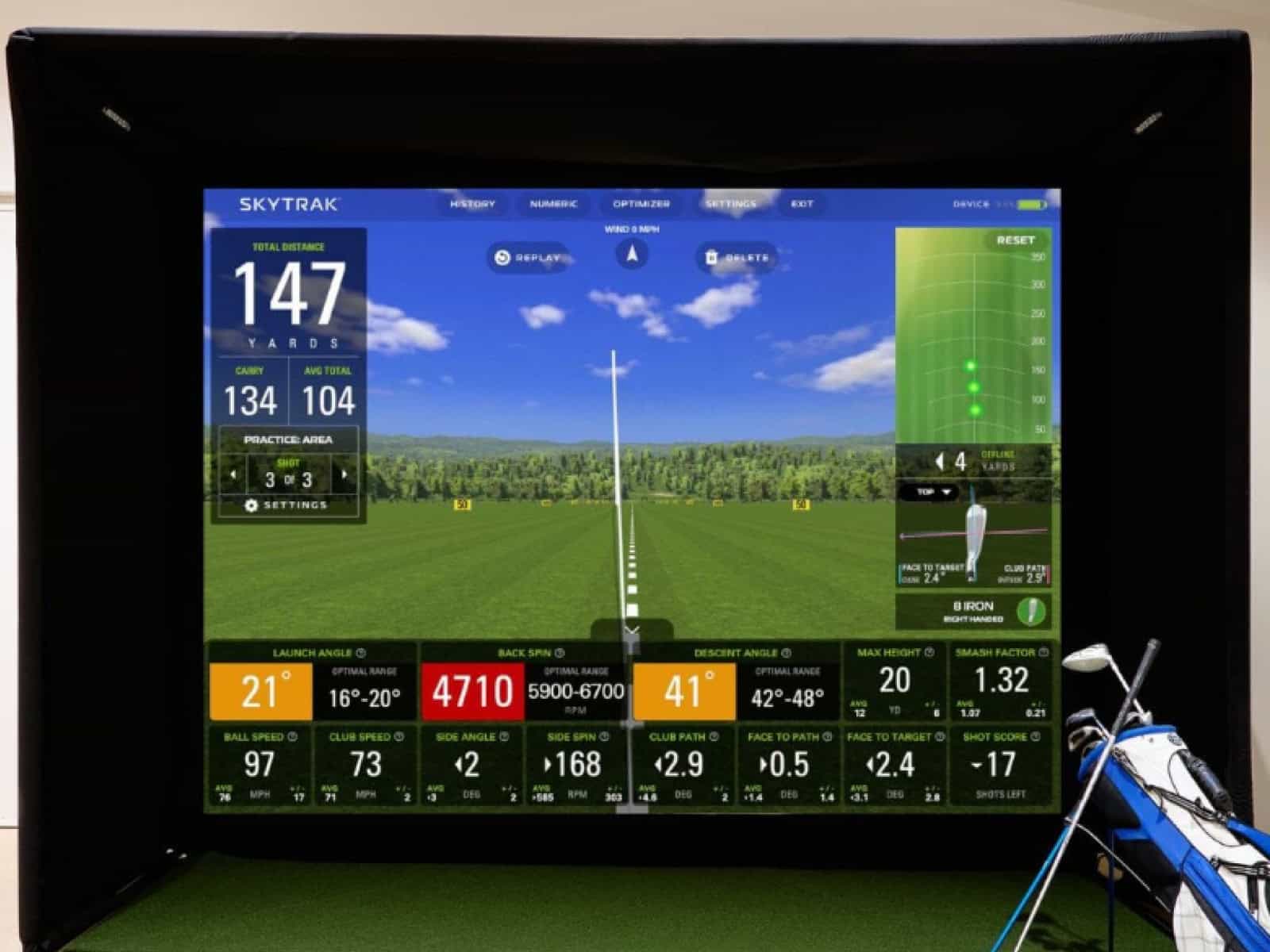For golfers seeking to sharpen their skills and lower their scores, simulators have become an invaluable tool. With advanced technology that provides immediate feedback and limitless repetition, simulators allow golfers to get quality training any time of day, regardless of weather.
This article provides actionable tips to structure productive training sessions that build swing technique, consistency, course management, and on-course performance.
While proper coaching, fitness, and real course play remain essential, regular simulator practice maximizes skill development through unparalleled convenience and efficiency.
Read on to learn how you can optimize your improvement with the feedback, flexibility, and focus a personal simulator provides. With thoughtful training, simulators are guaranteed to shave strokes off your scores.
Understanding the Value of Golf Simulators
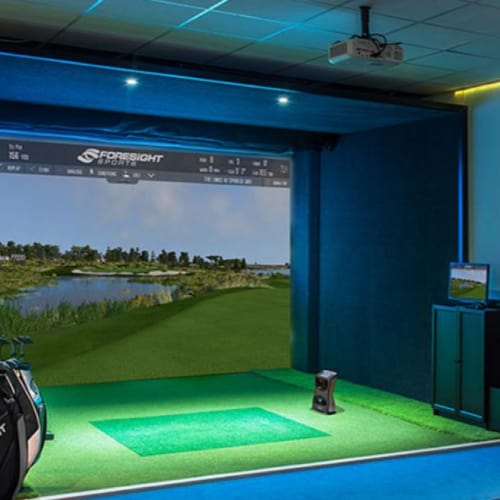
One of the biggest values of using a golf simulator is the ability to practice shots and work on your game without having to go to a driving range or course. This saves time and money spent on balls and equipment transportation. Simulators also allow golfing at any time of day, regardless of weather conditions.
Golf simulators utilize advanced launch monitors to provide immediate feedback and stats on every shot hit. Key data like ball speed, launch angle, spin rate, club path, and angle of attack can help identify weaknesses and shape specific practice goals. Launch monitors remove the guesswork on shot distance and dispersion by providing real numeric data for each shot. Learn more on how to read launch monitor and golf simulator data in this article.
Premium launch monitors like the TrackMan 4 and Foresight Sports’ GCQuad accurately measure shot data within a fraction of a degree. This level of precision is important for understanding the specifics of your swing and ball striking.
How Golf Simulators Can Improve Your Game

One of the biggest advantages of golf simulator practice is the ability to set up repetitive drills and record measurable progress over time. Being able to hit the same club to the same target over and over again builds tremendous muscle memory and consistency. Golfers can also practice using alignment aids more easily in a simulator than at a driving range.
Launch monitor feedback helps you zero in on weaknesses in your swing or ball striking. Common practice goals like increasing swing speed, hitting a draw or fade on demand, controlling wedge distances, and learning about your typical miss patterns are all ideally suited to simulator practice.
However, for golfers seeking to add some variety and further enhance their training sessions, utilizing golf training aids to help improve your game can be extremely beneficial.
Moreover, the ability to play full rounds on simulated courses also builds skills related to course management, focus, and working under pressure. While simulated golf cannot fully replicate the experience of playing an actual course, it provides a reasonable approximation to work on your mental game.
Advanced golf simulators provide tools to record videos of your swing from multiple angles, utilize smart caddies, get online lessons, compete in tournaments, and much more. This allows for comprehensive practice tailored to your unique improvement goals.
For those limited on time or with busy travel schedules, simulators enable quality skills training from the convenience of your own home or office. While outdoor range sessions have benefits as well, a personal golf simulator for practice is an ideal solution for golfers seeking to maximize their training sessions’ efficiency.
Using a Golf Simulator to Improve Your Game
Now that you understand the benefits of using a golf simulator, it’s time to focus on how to maximize your improvement once you start practicing indoors. There are many ways to structure your simulator sessions to efficiently develop your skills.
Keep a Practice Notebook

Keeping notes on your simulator practice can provide useful insights into your progress over time. Write down your main goals for each session along with key shot data like distances, dispersion, and other launch monitor numbers. Review your notes periodically to track positive trends.
A practice journal also helps identify weaknesses that need more work. If you consistently miss short irons left, make a note to spend more time on that. Go back through your notes when you hit a plateau to see where to focus your efforts next.
Get the Kids Involved
Golf simulators can be a fun way to introduce golf to children and get them engaged in the sport from a young age. The casual, game-like nature appeals more to kids than going to the range. Take advantage of their interest by involving them in your simulator practice.
Let them take some swings, compete in skills challenges, or play virtual courses together. Quality time golfing indoors is a great way to bond over your shared enjoyment of the game. It may just spark their own passion for golf!
Develop Junior Skills
The lessons learned using a simulator mimic those outdoors. The feedback provided develops the same skills in junior golfers regarding swing mechanics, ball striking, and shot shaping.
Younger kids can build confidence hitting shots without pressure. The simulator grants do-overs on mishits to keep things fun. As they improve, you can introduce competitive games or play simulated tournament venues to test their skills.
Simulators allow junior golfers to self-correct and learn at their own pace with instant feedback. And indoor practice means more reps and less time picking up balls!
Practice Modes in a Golf Simulator
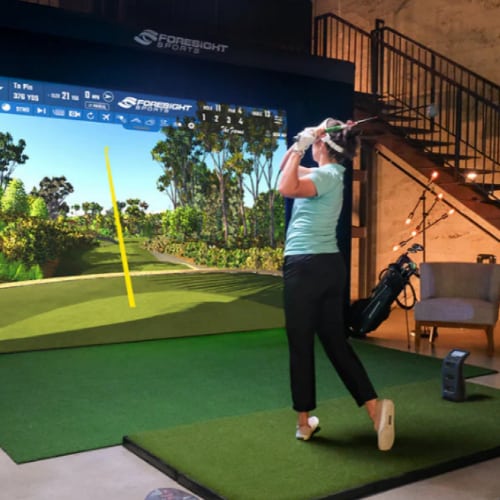
Simulators offer a variety of different practice modes and settings to focus your training. Taking advantage of these options allows you to zero in on specific skills and tailor sessions to your goals.
Block Distance Practice
Many simulators have a block distance mode that lets you choose a specific yardage and hit shots to that target. This is great for improving wedge distances and consistency.
Work through your bag starting with wedges. Hit 10 balls each from 30-40 yards, 40-100 yards, and so on up through your woods. This engrains your distances and control.
Wedge Distance Matrix
Building a matrix with all your wedge yardages provides a clear look at your distance gaps and consistency. Track full, 3/4, and 1/2 swings for each wedge.
Use the matrix to shape wedge practice sessions. If your 50-yard sand wedge is inconsistent, spend time hitting to that distance.
Distance Randomizer
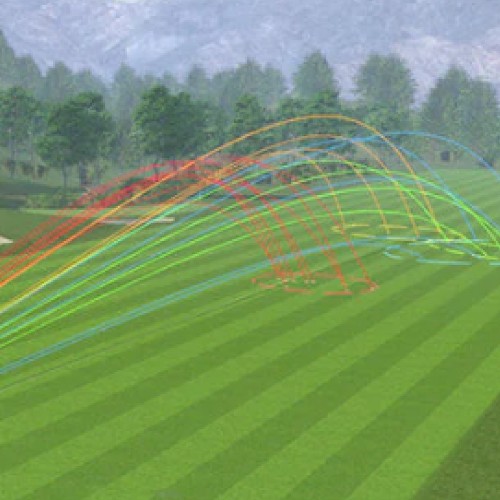
Randomizing club selection and/or distance is great for practicing adaptability. Let the simulator choose each shot for you to keep your focus sharp.
The randomness also improves decision-making, since you must assess and execute each shot without settled expectations.
Bag Mapping
Bag mapping displays all carry distances in your bag on a simulated hole to reveal strengths, weaknesses, and gaps.
This helps determine which clubs need more work. If you have big gaps in the scoring irons, prioritize practice there.
This feature also helps you plot your golf bag properly with the most useful clubs for your game for future practice sessions (both virtual and real).
Target Practice
Aim for specific targets like trees, bunkers, or fairway sections to improve accuracy. Make the targets incrementally smaller to increase the challenge.
Painting front and back targets works on distance control. Alternate clubs to master various trajectories into greens.
“Drop it Anywhere”
This creative mode scatters shots across the course to practice recoveries from bad lies. Work on scrambling and trouble shots by adapting to the situation.
Force yourself to manufacture different shots to save par. Flop shots, bump and runs, splash outs – be ready for anything!
Simulator Mulligans
Unlimited mulligans are a key benefit of simulator practice. Be disciplined only taking one to learn from mistakes and build consistency.
Allow yourself more on tough shots to experiment and work on your technique. But avoid overly relying on do-overs as a crutch.
Dispersion Practice
Choose a stock shot and location. Check dispersion patterns over 10-20 balls to master precision.
Pay attention to shot shape and curvature as well. Work on minimizing both for tighter shot groups.
Skills Challenges
Many simulator software programs offer fun skills challenges to test aspects like accuracy, consistency, obstacle avoidance, and more.
These can add some competition to range sessions. Try alternating normal practice with challenges to stay sharp.
Watching Your Swing on Camera in a Golf Simulator
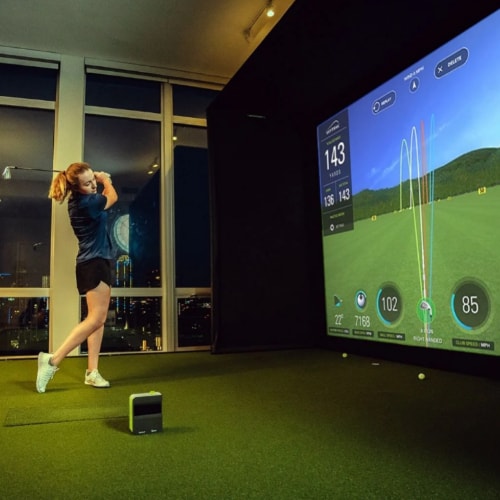
One of the most useful features of modern simulators is the ability to record and analyze your swing using integrated video and camera functions. Being able to watch your swing visually can provide key feedback to supplement the data from the launch monitor.
Viewing Different Swing Angles
High-end simulators have multiple cameras positioned to capture the swing from different angles – down the line, face on, overhead, and more.
Studying your swing video from various perspectives gives you a comprehensive visual of your mechanics, planes, and motions. This helps engrain proper positions.
Recording and Reviewing Your Swing
Recording swing video allows you to review and make changes. Pick a few key positions to check like takeaway, top of backswing, and impact.
Use software tools to draw lines and compare positions frame-by-frame. This will help you better understand what you are doing right or wrong and why.
Dialing In Your Pre-Shot Routine
Studying a video of your pre-shot routine can help solidify consistent patterns. Ingraining specific practice swings, waggles, and setup positions breeds repetition.
Time your routine on different clubs to find an optimal tempo. Remove any unnecessary movements caught on video for enhanced efficiency.
Launch Monitor App Features
Many launch monitor apps have integrated ability to sync and store your swing videos. This allows you to build a searchable database of swing clips.
Review sessions over time to check progress. Tag videos by club, session goals, or shot types to conveniently find certain clips.
Watching your swing on video in conjunction with launch monitor data provides a powerfully comprehensive analysis. Take full advantage of these features in your simulator practice.
Putting Practice in a Golf Simulator
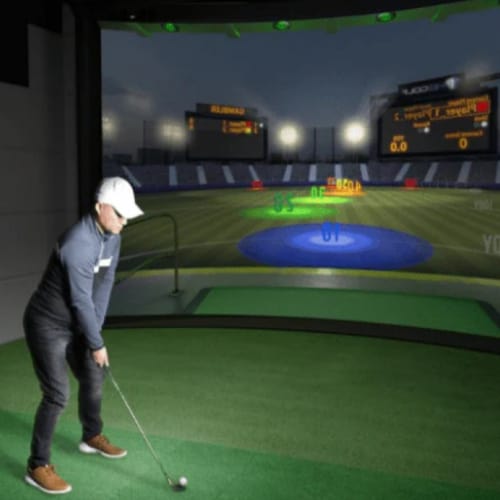
While simulators are focused mostly on the full swing, many also offer functionality for practicing your short game as well. Here are some of the ways you can incorporate productive putting sessions into your indoor training.
You May Also Like: The 10 Best Golf Putting Aids of 2026
Dedicated Putting Mats
High-end simulators have a dedicated putting mat area to work on short putts. Sensors track ball speed and direction to provide feedback on distance control.
Practice routines like 10 putts each from 3, 6, and 9 feet. Vary break amounts and track your percentage made.
Reading Simulated Greens
Use simulated putting greens to practice reading breaks and slopes. Visualizing the break and controlling speed are just like real putting.
If you struggle with reading breaks, turn on the simulator’s virtual “ball path” line to build consistency in your reading and adjustment.
Lag Putting
Choose longer putts 20+ feet and work on your touch and lag putting skills. Strive to finish within 3 feet and avoid 3-putts.
Pay attention to weight shift, tempo, and follow-through. Grooving a buttery smooth lag stroke minimizes long putts.
Custom Challenges
Design your own putting competitions and challenges to stay engaged. See how few putts it takes you to hole out from 100 feet away.
Work from all areas of the green to build confidence in your touch, line, and speed control from any distance.
Green Reading Exercises
Use the simulator software to flatten greens or exaggerate breaks. This helps develop your visual skills for reading subtle contours.
Identify the high and low points of each green after putting to build your mental map of the breaks.
Measure Progress Over Time
Log your simulator putting stats over time – percentage made from certain distances, number of putts per round, number of 3-putts, etc.
Tracking tangible progress motivates you to eliminate those pesky 3-putts!
While limited compared to real putting, simulator training still develops invaluable feel, touch, and green reading competency. Take advantage of this convenient way to sharpen your short-game skills at home.
Chipping Practice in a Golf Simulator
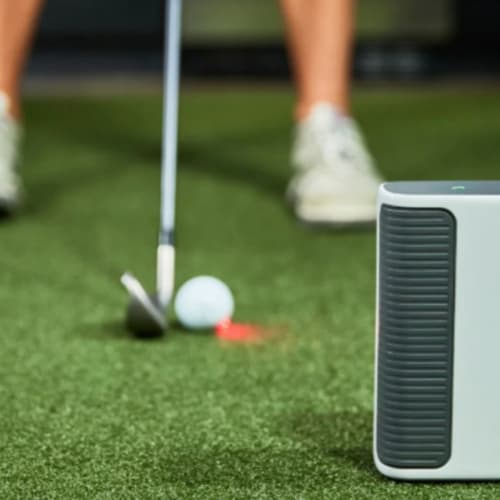
While limited compared to full shots, golf simulators can still provide some functionality for sharpening your chipping, pitching, and greenside skills. Here are a few ways to incorporate short game practice into your indoor sessions.
Pitch Shots
Use pitching and gap wedges to hit shots from 20-50 yards. Land shots on the green and watch them roll out.
Practice landing angle, spin and distance control. Hit to front/back pin locations to master the trajectory.
Tight Wedge Shots
Work on finesse wedge shots from 10-30 yards. Focus on crisp contact to take spin off and control rollout.
Aim for targets to improve accuracy. Drop balls in bunkers or rough to replicate real lies.
Flop Shots
Open the face for high soft-landing flop shots. Work on squaring the face at impact for solid contact.
Control trajectory using ball position and wrist action. Land them gently with lots of spin.
Chipping Technique
Use 7-9 irons to chip from 5-20 yards out. Dial in consistent contact and crisp ball-first strikes.
Practice chipping uphill and downhill lies to control distance through varied techniques.
Trouble Shots
Hit chip shots from sidehill, downhill, and awkward stances and lies. Force creativity to escape bad situations.
Use alignment aids to ingrain proper footwork, aim and ball position from uneven lies around the green.
Up and Down Challenges
Design games to practice getting up and down from different locations just off the green. Track your success rate.
Work on chipping and putting under pressure. Limit strokes to build scrambling and recovery competency.
Chipping nets and mats are great low-cost practice aids to add greenside training at home in your simulator. Take advantage of these accessories to become a short-game wizard!
Maximizing Your Improvement in Your Simulator
While simulators provide excellent training capabilities, you must utilize them effectively to actually see tangible results in your game. Here are some tips to maximize your development when practicing indoors:
Create a Practice Plan

Approach each session with a defined plan – don’t just randomly hit balls. Identify 2-3 specific skills to work on and track progress.
Design drills and challenges that force adaptation. Schedule different plan focuses like long game, wedges, accuracy, etc.
Precise Goals
Set very specific goals for each session beyond just hitting balls. Narrow your focus like increasing driver carry by 5 yards or hitting 80% GIRs from 75-100 yards.
Define your own curated practice competitions to stay motivated. Strive for tangible results through deliberate skills development.
Measure Everything
The data provided by launch monitors is invaluable – use it fully! Log shot distances, dispersion, ball flight, swing speed, angles, etc.
Review the data over time to identify true weaknesses. Numbers don’t lie – they prevent you from fooling yourself.
Film Your Swing
Record your swing from various angles to correlate feel with real mechanics. Watch footage frame-by-frame to engrain positions.
Compare videos side-by-side to monitor progress over weeks and months.
Compete Against Yourself
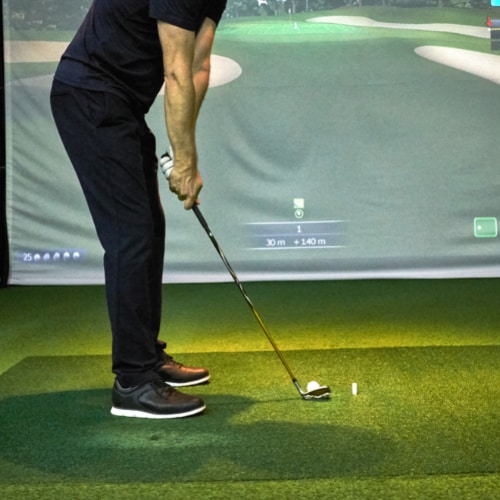
Try to be a better player than the one you were before (two weeks ago, two months ago, etc.). Design challenges and competitions to stay motivated. For instance, see how many 3-foot circles you can hit in a row from 100 yards.
Use games to build mental fortitude. Simulate pressure situations and learn to thrive.
Monitor Strike and Dispersion
Two essential factors are solid contact and accuracy. Use footprint spray or impact stickers to monitor the quality of your stroke.
Paint impact circles on mats and measure shot dispersion. Master consistent ball-first contact and tight groups.
Practice Uncomfortable Shots
Don’t only hit full swing stock shots on the simulator. Intentionally hit draws, fades, punches, flops, and other specialty shots.
Force adaptation by practicing shots you avoid on course due to anxiety or lack of confidence.
Make Adjustments
If you start dropping shots or curving, don’t keep hitting and ingraining compensations. Stop and self-diagnose the issue.
Your swing thoughts and feels will vary day to day. Stay present and adjust on the fly.
Implement these tips to get the most out of your golf simulator practice sessions. Thoughtful, purposeful training leads to lowered scores!
Final Thoughts
Golf simulators provide an excellent way to practice and improve your skills indoors. Taking advantage of the latest simulator technology allows you to get quality training regardless of weather or time constraints.
When visiting an indoor golf simulator facility, it’s important to dress appropriately to ensure comfort and optimal performance. To learn more about the recommended golf simulator dress code, check out our guide on what to wear to an indoor golf simulator.
While simulated golf has limitations compared to real course play, the benefits of simulator training are outstanding. Understanding how putting work on a golf simulator can help you make the most of this technology. Regularly utilizing the feedback and repetition available from launch monitor-based golf simulators is sure to drop strokes from your scores.
Complement simulator practice with traditional range sessions, lessons, fitness training, and actual rounds for comprehensive improvement. But for convenience, efficiency, and rapid skill development, nothing beats your own in-home golf simulator!



